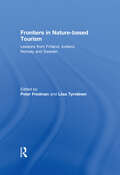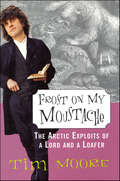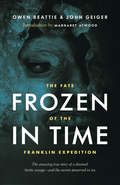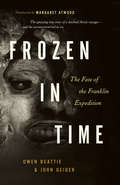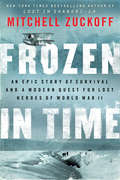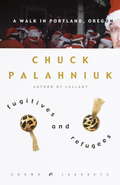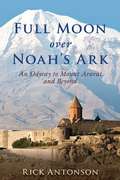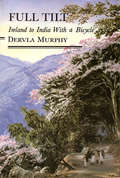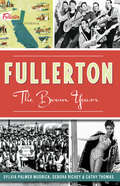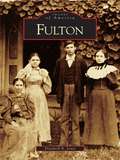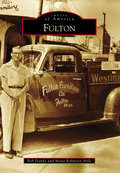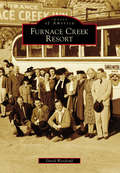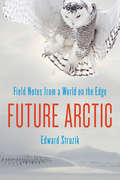- Table View
- List View
Frontiers in Geographical Teaching (Collected Works of Richard J. Chorley)
by Richard J. Chorley Peter HaggettOriginally published in 1965 and with a second edition in 1970. Building upon the original two Madingley Hall seminars for teachers of non-university geography in 1965, this book presents an updated research picture of the 1970 transatlantic perspective. Answering the questions "What is happening in geography" and "What impact does this have on school geography", this provided a real link for students who were then making the increasingly difficult transition from school to university geography. Originally receiving a hostile reaction from British journals, the book’s diagnosis and prognosis were a forerunner of developments in methodological changes of the discipline. This work collects a series of essays delineating geographic concepts in terms of the philosophic underpinnings, assessment of the geomorphic system, climatology, and social economic and historical changing trends. Techniques are reviewed including quantitative methods for geomorphology and social geography, fieldwork both in urban areas and land-use surveys, and finally in physical planning. Final analyses examine and contrast the teaching methods and courses in American and British High Schools, Colleges and Universities.
Frontiers in Nature-based Tourism: Lessons from Finland, Iceland, Norway and Sweden
by Peter Fredman Liisa TyrväinenNature has been a key attraction factor for tourism in the Nordic countries for decades. The demand for nature-based tourism has steadily grown and is one of the most rapidly expanding sectors within tourism across Europe and elsewhere. This demand has created opportunities for nature-based tourism to develop as an economic diversification tool within regions rich in natural amenities. But nature-based tourism is not only about tourism businesses and tourists visiting nature. The natural environment as a basis for tourism involves many challenges related to local communities, public access, nature protection and the management of natural resources.This book covers a broad set of topics in contemporary nature-based tourism from Finland, Iceland, Norway and Sweden. Areas discussed are innovation, fishing rights and supply of angling, recreation experience preferences, national park attractions, the cultural clash between established outdoor recreational use and new tourism activities, the Right of Public Access as opportunity and obstacle, preferences of tourism landscapes, controversies around wilderness development, management of hiking trails, eco-tourism certification, and financing of recreational infrastructure.This book was published as a special issue of the Scandinavian Journal of Hospitality and Tourism.
Frontiers of Belonging: The Education of Unaccompanied Refugee Youth (Worlds in Crisis: Refugees, Asylum, and Forced Migration)
by Annika LemsAs unprecedented numbers of unaccompanied African minors requested asylum in Europe in 2015, Annika Lems witnessed a peculiar dynamic: despite inclusionary language in official policy and broader society, these children faced a deluge of exclusionary practices in the classroom and beyond. Frontiers of Belonging traces the educational paths of refugee youth arriving in Switzerland amid the shifting sociopolitical terrain of the refugee crisis and the underlying hierarchies of deservingness. Lems reveals how these minors sought protection and support, especially in educational settings, but were instead treated as threats to the economic and cultural integrity of Switzerland. Each chapter highlights a specific child's story—Jamila, Meron, Samuel, and more—as they found themselves left out, while on paper being allowed "in." The result is a highly ambiguous social reality for young refugees, resulting in stressful, existential balancing acts. A captivating ethnography, Frontiers of Belonging allows readers into the Swiss classrooms where unspoken distinctions between self and other, guest and host, refugee and resident, were formed, policed, and challenged.
Frost on my Moustache: The Arctic Exploits of a Lord and a Loafer
by Tim MooreGuided by the fastidious journals of an eminent Victorian adventurer by the name of Lord Dufferin, Time Moore sets off to prove his mettle in the most stunningly inhospitable place on Earth-the Arctic. Armed only with his searing wit, wicked humor, and seasickness pills, our pale suburbanite-wracked by second thoughts of tactical retreat-confronts mind-numbing cold, blood-thirsty polar bears, a convoy of born-again Vikings, and, perhaps most chilling of all, herring porridge. When he is not humiliating himself through displays of ignorance and incompetence, Moore casts a sharp eye on the local flora and fauna, immersing readers in the splendors and wonders of this treacherously beautiful region.A deliciously and inexhaustibly funny book, Frost on My Moustache deserves to be placed alongside those by Evelyn Waugh, Eric Newby, and Bill Bryson.
Frozen in Time
by John Geiger Owen BeattieThe Franklin expedition was not alone in suffering early and unexplained deaths. Indeed, both Back (1837) and Ross (1849) suffered early onset of unaccountable "debility" aboard ship and Ross suffered greater fatalities during his single winter in the Arctic than did Franklin during his first. Both expeditions were forced to retreat because of the rapacious illness that stalked their ships. Frozen in Time makes the case that this illness (starting with the Back expedition) was due to the crews' overwhelming reliance on a new technology, namely tinned foods. This not only exposed the seamen to lead, an insidious poison - as has been demonstrated in Franklin's case by Dr. Beattie's research - but it also left them vulnerable to scurvy, the ancient scourge of seafarers which had been thought to have been largely cured in the early years of the nineteenth century. Fully revised, Frozen in Time will update the research outlined in the original edition, and will introduce independent confirmation of Dr. Beattie's lead hypothesis, along with corroboration of his discovery of physical evidence for both scurvy and cannibalism. In addition, the book includes a new introduction written by Margaret Atwood, who has long been fascinated by the role of the Franklin Expedition in Canada's literary conscience, and has made a pilgrimage to the site of the Franklin Expedition graves on Beechey Island.
Frozen in Time
by Margaret Atwood John Geiger Owen BeattieThe truth about what happened on Sir John Franklin's ill-fated Arctic expedition of 1845-48 has been shrouded in mystery for 165 years. Carrying the best equipment that the science and technology, Franklin and his men set out to "penetrate the icy fastness of the north, and to circumnavigate America." The expedition's two ships - HMS Erebus and HMS Terror - carrying 129 officers and men, disappeared without a trace. From 1846 to 1880 more than 20 major rescue parties were involved in the search for the missing men and ships. The disappearance of the expedition and absence of any substantial written accounts of the journey have left attempts at a reconstruction of events sketchy and inconclusive. In Frozen in Time, forensic anthropologist Owen Beattie and historian John Geiger tell the dramatic story of the excavation of three sailors from the Franklin Expeditions, buried for 138 years on the lonely headland of Beechey Island. This book contains the astonishing photographic record of the excavation, together with the maps and illustrations that accompany this riveting account of Franklin's fatal adventure. The unfolding of Dr. Beattie's unexpected findings is not only a significant document but also, in itself, a tale of high adventure.
Frozen in Time
by Margaret Atwood John Geiger Owen BeattieThe revised text of "Frozen in Time" expands on the history of nineteenth century British Arctic exploration and specifically the Franklin expedition, placing it in the context of other expeditions of the era, including those commanded by George Back and James Clark Ross.The Franklin expedition was not alone in suffering early and unexplained deaths. Indeed, the expeditions of both Back (1837) and Ross (1849) were forced to retreat because of the rapacious illness that stalked their ships. The authors make the case that this illness was due to the crews' overwhelming reliance on a new technology: tinned foods. This not only exposed the seamen to lead, an insidious poison, but also left them vulnerable to scurvy.The revised "Frozen in Time" will also update the research outlined in the original edition, and will introduce independent confirmation of Dr. Beattie's lead hypothesis, along with corroboration of his discovery of physical evidence for both scurvy and cannibalism. In addition, the book includes a new introduction written by Margaret Atwood, who has long been fascinated by the role of the Franklin Expedition in Canada's literary conscience.Includes never before seen photographs from the exhumations on Beechey Island and rarely seen historical illustrations.
Frozen in Time
by Mitchell ZuckoffThe author of the best-selling Lost in Shangri-La recounts the November 1942 crash of a U. S. cargo plane into the Greenland Ice Cap, the loss of the B-17 sent to find it, and the loss of a Grumman Duck amphibious plane that had managed to rescue one B-17 crew member. The remaining crew endured 148 days of Arctic winter before finally being rescued. With a 200,000-copy first printing.
Fruita (Images of America)
by Steve Hight Denise HightWilliam Pabor arrived in Western Colorado before the advent of irrigation, and the land presented a barren and desolate sight. But he saw something entirely different. "In the spring of 1884, lying on the bare floor of a log cabin on the site of what is now the town of Fruita, I watched the moonbeams play on the Roan Cliffs and across Pinon Mesa," Pabor wrote. "The silence of centuries seemed resting upon the plain. . . . But visions of the possibilities of the future swept before me. I saw homes founded, I saw family circles gathered together. I saw vineyards and orchards, and rose-embowered cottages in which love and happiness and contentment abode. . . . I heard the merry voices of children yet to be born. I heard the singing of harvesters bringing in the sheaves of golden grain." Pabor soon turned vision into reality and founded the town of Fruita.
Fruits of Bali
by Fred B. Eiseman Margaret EisemanBali's Succulent Tropical Fruits make a vivid ans lasting impression on every visitor. Fruits of Bali is a field guide to this cornucopia of exotic shapes, tastes, and smells - providing photographs and descriptions of some 50 varieties, as well as fascinating botanical and background information and tips on buying and preparing the fruits yourself. Even familiar fruits acquire a distinct taste and texture in the island's tropical environment, and those unique to the region provide a surprising and delicious experience.
Fugitives and Refugees: A Walk in Portland, Oregon (Crown Journeys)
by Chuck PalahniukThe author of the best-selling novel reveals his favorite Portland, Oregon landmarks in this autobiographical travel guide that describes the City of Roses as "the home of America's fugitives and refugees." Covering a bit of culture and a bit of history, the guide begins with a Portland vocabulary lesson and then offers descriptive listings of selected restaurants (with key recipes), architecture, museums, swingers' sex clubs (gay and straight), events, transportation, shopping, and photo opportunities, along with wry commentary from the author. The guide does not include maps, photographs, or an index. Annotation (c)2003 Book News, Inc., Portland, OR (booknews.com)
Full Moon over Noah's Ark: An Odyssey to Mount Ararat and Beyond
by Rick AntonsonAcclaimed travel writer Rick Antonson sets his adventurous compass on Mount Ararat, exploring the region’s long history, religious mysteries, and complex politics.Mount Ararat is the most fabled mountain in the world. For millennia this massif in eastern Turkey has been rumored as the resting place of Noah’s Ark following the Great Flood. But it also plays a significant role in the longstanding conflict between Turkey and Armenia.Author Rick Antonson joined a five-member expedition to the mountain’s nearly 17,000-foot summit, trekking alongside a contingent of Armenians, for whom Mount Ararat is the stolen symbol of their country. Antonson weaves vivid historical anecdote with unexpected travel vignettes, whether tracing earlier mountaineering attempts on the peak, recounting the genocide of Armenians and its unresolved debate, or depicting the Kurds’ ambitions for their own nation’s borders, which some say should include Mount Ararat.What unfolds in Full Moon Over Noah’s Ark is one man’s odyssey, a tale told through many stories. Starting with the flooding of the Black Sea in 5600 BCE, through to the Epic of Gilgamesh and the contrasting narratives of the Great Flood known to followers of the Judaic, Christian and Islamic religions, Full Moon Over Noah’s Ark takes readers along with Antonson through the shadows and broad landscapes of Turkey, Iraq, Iran and Armenia, shedding light on a troubled but fascinating area of the world.Skyhorse Publishing, as well as our Arcade imprint, are proud to publish a broad range of books for readers interested in history--books about World War II, the Third Reich, Hitler and his henchmen, the JFK assassination, conspiracies, the American Civil War, the American Revolution, gladiators, Vikings, ancient Rome, medieval times, the old West, and much more. While not every title we publish becomes a New York Times bestseller or a national bestseller, we are committed to books on subjects that are sometimes overlooked and to authors whose work might not otherwise find a home.
Full Steam Ahead, Felix: Adventures of a famous station cat and her kitten apprentice
by Kate MooreTHE SUNDAY TIMES BESTSELLER 'FULL OF FUNNY AND HEART-WARMING STORIES' Sunday ExpressThe charming sequel to Felix the Railway Cat, with more exciting adventures from his life on and off duty at Huddersfield Railway Station. Felix, Senior Pest Controller at Huddersfield station, has been at the heart of a close-knit community since the day she arrived as a kitten. But now, having risen to fame, everyday life at the station has become rather hectic; while reporters and fans clamour for a glimpse of her, Felix and her human co-workers find themselves, and the station, in quite a whirlwind. With the job seemingly too big for one fluffy feline to handle, it seems only sensible to recruit a young apprentice to the team: enter, Bolt. Full of funny and heart-warming stories, with personal tales from Felix's biggest fans, this is the remarkable tale of Felix and Bolt, the ultimate pest-controlling duo.AS SEEN ON THE ONE SHOW & GOOD MORNING BRITAINPraise for Felix the Railway Cat: 'The global sensation' Daily Telegraph'A phenomenon' Big Issue'The purrfect railway cat' Daily Express Royalties from the sale of this book will be donated to Huddersfield Samaritans and Action for Children
Full Tilt
by Dervla MurphyFulfilling a childhood dream, Dervla Murphy embarked in 1963 on an epic journey from Dunkirk to Delhi with her trusty bicycle, Roz. She began her trek during the worst winter in living memory, and even when the weather improved there were enough difficulties and dangers to satisfy the most intrepid of travellers. Her resourcefulness, however, matched up to her unexpected encounters, and she turned a blind eye to personal danger and discomfort. Yet, everywhere she ventured, she was met with kindness and hospitality, which is the focus of this travel diary.
Full Tilt: Ireland to India with a Bicycle
by Dervla MurphyA bicycle trek across two continents. Based on her daily diary, this is Dervla Murphy's account of her ride, in 1963, across frozen Europe and through Persia and Afghanistan, over the Himalayas to Pakistan and into India, during one of the worst winters in memory. She has written other travel books, including In Ethiopia with a Mule.
Full Tilt: Ireland to India with a Bicycle
by Dervla MurphyA bicycle trek across two continents. Based on her daily diary, this is Dervla Murphy’s account of her ride, in 1963, across frozen Europe and through Persia and Afghanistan, over the Himalayas to Pakistan and into India, during one of the worst winters in memory. She has written other travel books, including In Ethiopia with a Mule.
Fullerton: The Boom Years
by Cathy Thomas Sylvia Palmer Mudrick Debora RicheyAmerica enjoyed newfound prosperity in the decades following World War II, and Southern California was an epicenter of postwar growth. Among the many Orange County communities that grew and flourished in this hopeful and exciting era, Fullerton led the way. Join authors Sylvia Palmer Mudrick, Debora Richey and Cathy Thomas as they recount Fullerton's boom years. It was a time characterized by economic growth, vibrant development and engaged civic participation. From the founding of the world-famous Fender guitar company to the establishment of Fullerton's first university, discover the events and people that transformed Fullerton from a small town to a thriving city.
Fulton
by Elizabeth R. JonesLocated in the southwestern part of the state, Fulton, Kentucky was first known as Pontotoc by the native Chickasaw Indians. The town was founded in 1828, along with its sister city, South Fulton, Tennessee, when Benjamin Franklin Carr purchased 160 acres from the Commonwealth of Kentucky. The town was labeled the "end of the line" by the federal government due to its pivotal position at the termination point of the Paducah-Memphis rail-all mail sent to the region was addressed as such. Images of America: Fulton follows the agricultural and industrial development of the region, and provides local folklore as well.
Fulton (Images of America)
by Bob Franks Mona Robinson MillsFulton is one of the oldest cities in northern Mississippi. Established on May 11, 1837, by an act of the Mississippi legislature, the city is the northernmost town on the Tombigbee River, located less than 10 miles south of that river’s headwaters. Fulton was settled by hardy pioneers seeking new opportunities in the newly available lands of Mississippi’s Chickasaw Cession. From its first days, Fulton was the center of commercial activity in Itawamba County, as well as the home to county government. During the Civil War and Reconstruction, the town declined, until a period of new growth and activity took place during the early 20th century. At that time, the timber industry became a lucrative venture, and the Mississippian Railway was established, connecting Fulton to the Frisco Railroad in Amory, 20 miles to the south. Fulton is now home to Itawamba Community College and is adjacent to the Tennessee-Tombigbee Waterway, one of the largest inland waterways in the nation.
Fundamental Concepts and Functions of Passenger and Freight Transportation in Great Britain
by Mengqiu CaoThis book provides a comprehensive overview of the fundamental concepts and function of transport, as well as covering a wide array of themes, including different modes of both passenger and freight transport, primarily using various case studies from Gre
Fundamentals of Destination Management and Marketing
by Rich HarrillIACVB offers a series of stand-alone educational meetings, specific to the previously mentioned interactive learning shirtsleeves tracks, based on primary job responsibility or professional expertise. During these meetings, members convene with others in their professional area to share ideas, review programs that may or may not have worked, or discuss how to handle specific situations. The IACVB currently offers the following meetings: CEO Forum, COO/CFO Forum, Membership Shirtsleeves, Sales & Marketing Executive Forum, and Visitor Services Shirtsleeves.
Fundamentals of Leisure Business Success: A Manager's Guide to Achieving Success in the Leisure and Recreation Industry
by William WinstonIn Fundamentals of Leisure Business Success, you'll sidestep the theoretical, overly academic jargon that often bogs down books dealing with leisure and recreation and discover many revolutionary, practical ways that these theories translate into the everyday realities of market share, employee management, and all-out business survival. You'll have the benefit of 20 years of actual experience in the leisure and recreation field at your disposal so you can master the importance of contemporary business and management techniques.
Furnace Creek Resort: A History Of Furnace Creek Resort And Its Evolution Into The Oasis Of Death Valley (Images of America)
by David WoodruffSince opening on February 1, 1927, with just 12 guest rooms, Furnace Creek Resort has achieved preeminence among US National Park lodges and hotels. Conceived by the Pacific Coast Borax Company in 1926, the inn was the answer to the declining mining industry, which had left the Death Valley Railroad with nothing to haul. The construction of Furnace Creek Inn helped to shift Death Valley's draw from mining to tourism, bringing a new industry to the Old West. Steeped in history and tradition, the inn and the ranch have become as much a destination as the park itself. With naturally heated swimming pools, the world's lowest golf course, four-diamond hospitality, and surroundings of unsurpassed natural beauty, Furnace Creek offers experiences that are long remembered by its guests.
Future Arctic: Field Notes from a World on the Edge
by Edward StruzikIn one hundred years, or even fifty, the Arctic will look dramatically differthan it does today. As polar ice retreats and animals and plants migrate northward, the arctic landscape is morphing into something new and very differfrom what it once was. While these changes may seem remote, they will have a profound impact on a hof global issues, from international politics to animal migrations. In Future Arctic, journalist and explorer Edward Struzik offers a clear-eyed look at the rapidly shifting dynamics in the Arctic region, a harbinger of changes that will reverberate throughout our entire world.Future Arctic reveals the inside story of how politics and climate change are altering the polar world in a way that will have profound effects on economics, culture, and the environmas we know it. Struzik takes readers up mountains and cliffs, and along for the ride on snowmobiles and helicopters, sailboats and icebreakers. His travel companions, from wildlife scientists to military strategists to indigenous peoples, share diverse insights into the science, culture and geopolitical tensions of this captivating place. With their help, Struzik begins piecing together an environmental puzzle: How might the land's miconic species—caribou, polar bears, narwhal—survive? Where will migrating birds flock to? How will ocean currents shift? And what fundamental changes will oil and gas exploration have on economies and ecosystems? How will vast unclaimed regions of the Arctic be divided?A unique combination of extensive on-the-ground research, compelling storytelling, and policy analysis, Future Arctic offers a new look at the changes occurring in this remote, mysterious region and their far-reaching effects.
Future Flight: A Review of the Small Aircraft Transportation System Concept
by National Research Council Transporation Research BordTRB Special Report 263 - Future Flight: A Review of the Small Aircraft Transportation System Concept reviews the plausibility and desirability of the SATS concept, giving special consideration to whether its potential net benefits--from user benefits to overall environmental and safety effects--are sufficiently promising to warrant public-sector investment in SATS development and deployment.The Small Aircraft Transportation System (SATS) program has been established by the Office of Aerospace Technology in the National Aeronautics and Space Administration (NASA). In the initial 5-year phase of the program, NASA is working with the private sector and university researchers, as well as other federal and state governmental agencies, to further various aircraft-based technologies that will increase the safety and utility of operations at small airports, allow more dependable use of small airports, and improve the ability of single-piloted aircraft to operate safely in complex airspace. Guiding this program is a longer-range SATS vision of the routine use of advanced, small fixed-wing aircraft for personal transportation between communities.The Small Aircraft Transportation System (SATS) is envisioned as relying on increasingly sophisticated and affordable small aircraft flying between small airports in lightly used airspace. The system was proposed to provide a growing share of the nation’s intercity personal and business travel. The development of such a system was considered to be justified by the potential to ease congestion in the existing aviation system and on highways serving densely traveled intercity markets. Without attempting to prejudge how advances in general aviation technology might evolve and affect travel markets, the committee that examined the SATS concept concluded that the concept is problematic in several ways as a vision to guide NASA’s technology development. Although the cost of small jet engines developed in partnership with NASA could drop dramatically, small jets would still be well beyond the means of all but the wealthiest members of society. The aircraft might be adopted by firms offering air taxi service, but the cost of such service would likely remain steep; therefore, sufficient market penetration to relieve congestion at hub airports would be unlikely. Moreover, the origins and destinations of most business travelers are major population centers, making travel to and from remote general aviation airports unappealing. The cost to upgrade such airports would be substantial as well, even assuming that SATS aircraft would have onboard technologies that would reduce the need for airport radars, precision landing guides, and air traffic control. The environmental consequences could also be substantial—particularly an increase in aircraft noise in rural areas unaccustomed to such intrusions. Perhaps the most difficult issues to address would be public concerns about safety. Finally, the use of SATS aircraft in and around major metropolitan areas would complicate an already overstressed air traffic control system, and the human factors issues of increased automation for relatively inexperienced pilots are far from being resolved.For all of the above reasons, the committee did not endorse the SATS concept as a guide for NASA R&D. The committee noted, however, that NASA’s support for ongoing technology development in general aviation is welcome and needed. General aviation has a much worse safety record than commercial aviation. The committee recommended that NASA work with other federal agencies, such as USDOT, the Federal Aviation Administration, and the National Transportation Safety Board in defining and pursuing opportunities to advance and improve general aviation.

